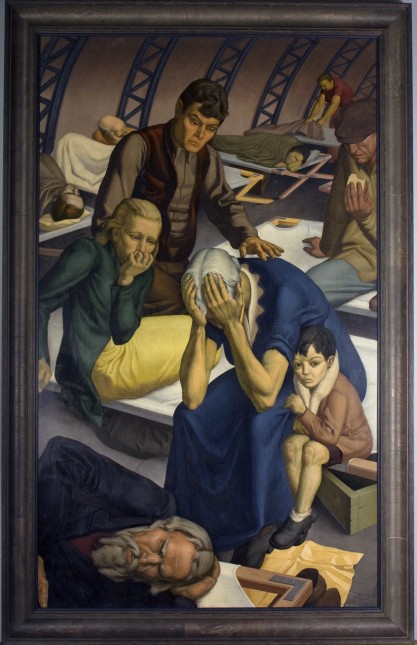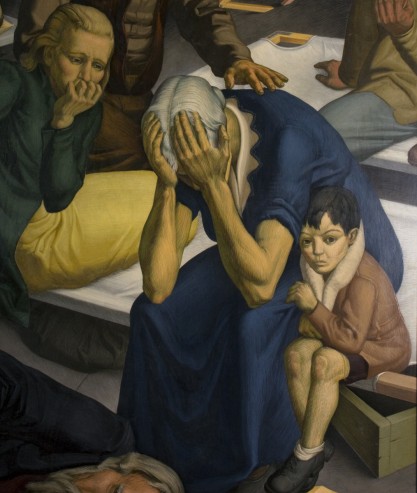


A poignant, large and decorative mural which reflects upon the devastation and loss caused by the Hartford, Connecticut floods of 1936. Workers from the Works Progress Administration (WPA) program provided flood relief, patrolling city streets, and rescuing Hartford residents in row boats. This large iconic artwork captures the Great Depression’s bleak urgency and despair in muted banal tones from within the temporary government shelter with newly widowed survivors and children reeling in the devastation.
 |
| Above: A WPA crew at work amidst the flood’s devastation |

The Connecticut based artist Alton Tobey began his career in the midst of the Depression and worked as an active WPA artist in the Federal Art Project, creating murals throughout Connecticut. His work can be seen in the East Hartford, CT post office, and the Hartford Library. Later in his career the artist returned to mural work, creating pieces for the Smithsonian Institute and Douglas MacArthur memorial. Other highlights of Tobey’s career include a series of profound illustrations recounting the saga of humanity from the Neolithic period to the 20th century called “The Epic of Man,” which he created on commission for “Life Magazine” where he also worked as a cover illustrator.


The Flood of 1936:
On March 12, 1936, rain began falling across Connecticut, as well as all of New England, and poured down for the next nine days. Fourteen inches of rain, coupled with melting snows from the area’s mountains, unleashed on Connecticut the greatest floods in its history to that date. The Connecticut and Farmington Rivers and all of their tributaries became raging torrents. Water and ice flows tore out bridges, highways, roads, and railways. The dam at New Hartford burst, and homes and buildings were washed away or destroyed. The waters at Hartford rose to a level of 8.6 feet higher than any previous flood level on record, flooding most of the downtown commercial area. Fourteen thousand people were left homeless, several were dead or missing, and epidemic disease threatened the population. The National Guard was called to action as the ravaging floods paralyzed business, traffic, communication, and home life, as the cities and towns along the rivers became the principal centers of destruction. While loss of life was small, damages exceeded $100 million, making it the costliest New England weather event to that time.
